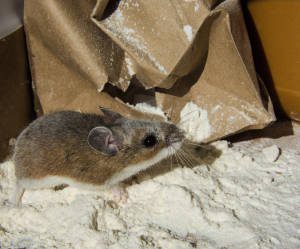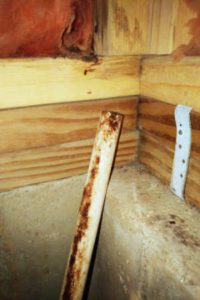HOW DO I KNOW IF I HAVE A MOUSE PROBLEM?
By Chris Williams on November 21, 2019.
You might think that’s a dumb question. Surely anyone with mice living in their home would know that they have mice living in their home. Not necessarily. Rodents are successful in part because they can remain hidden when they have to, they forage under cover of darkness, and they nest in out-of-the-way places that are rarely disturbed. They don’t want to be discovered for obvious reasons. An extended family of mice could be living in your wall voids or your attic and only coming out at night to sneak crumbs or pet food in the kitchen!
 Under those circumstances, you may not know that you are entertaining mice until their numbers get large enough (and that doesn’t take long) for you to notice the telltale evidence they leave behind. These are the signs that you have mice, with the most obvious first:
Under those circumstances, you may not know that you are entertaining mice until their numbers get large enough (and that doesn’t take long) for you to notice the telltale evidence they leave behind. These are the signs that you have mice, with the most obvious first:
LOOK FOR EVIDENCE OF MICE
Mouse droppings, aka “poop” – Mouse droppings are usually the first and most obvious signs because mice don’t care where they poop. In fact, they poop out about 70 individual pellets during the course of a day, as they move about and all along their travel routes. Mouse droppings are black (when fresh) or gray (if older), elongate, and more or less pointed at each end, about 1/4 inch long (see All About Mouse Poop!). Mouse droppings are just as likely to be out in the open and visible, not hidden away like mouse nests or gnawing damage.
If you’ve had mouse problems in the past, don’t confuse old, dry droppings with those from a current mouse infestation. Fresh droppings are shiny black and have the soft consistency of putty if squeezed. Old droppings are dull, gray, and brittle and tend to break apart if squeezed.
Nests and nest material – Mouse nests are built in dark, isolated places at ground level where the female mouse and her brood won’t be disturbed, yet are near a food source (usually within 30 feet). The back corner of a lower kitchen cabinet behind little-used equipment is a typical spot. Other common nest sites are the back of a pan drawer under a stove, or behind a refrigerator, a back corner of a closet, or a dresser drawer, boxes stored in a garage or basement, or wall voids near a food source.
A mouse nest is not a neat little ball of fluff as you may think. It is constructed by the female of whatever soft materials she can find (string, tissues, yarn, fabric, leaves, paper towels, bits of insulation, pet hair, dryer lint) but is more often a loose, messy flattened mat, about the size of a grapefruit. The nest can also contain bits of hoarded food, droppings, and baby mice.
Mouse nests can be nearby and never discovered unless and until you know to look for them (see Where Do Mice Nest?)
Gnawing damage – Mice, like all rodents, have prominent teeth and like to use them. They gnaw on materials mostly to gain access to food or shelter. If they find a tiny hole or crack, or any place they can sink their teeth into, they will enlarge it by gnawing until they can fit through (see Did a Mouse Make That Hole?). They prefer to gnaw on softened wood but will successfully chew holes in many materials: plastic, rubber, leather, asphalt, fiberglass, even mortar.
Typical places to find access holes gnawed by mice are around the water pipes that enter underneath a kitchen sink, at a lower corner of an outside door, or through the rubber gasket under a garage door. Sites with gnawing damage are good candidates for mouse exclusion measures (ask us about installing gnaw-proof materials in susceptible sites).

Heavy mouse rub marks in a basement on PVC pipes and concrete sill. Z. Ciras
Rub marks – If you’re not sure if that hole you found was made by a mouse, look for rough edges, wood shavings below, and rub marks around the opening. Rub marks are dark, greasy stains from the oils in a rodent’s hair that build up along any surface that the mice brush against frequently. Rub marks are yet another positive sign of the presence of mice but will be less noticeable in a new infestation. Smeary, dark rub marks can also be found along baseboards, pipes, or other objects that line a mouse’s runways or pathways. Rub marks found in a basement, behind stored items, or in an area not frequently used could be old.
Other miscellaneous signs of mice – If you have a pet, it might alert you to the presence of mice with barking, clawing, whining, or a stake-out of a nest site. Scratching or chirping sounds from a nest would get a pet’s attention. In a heavy or long-term infestation, you may be able to smell mice or their nests. More often, residents are first alerted to mice by smell when one dies in a wall void or other inaccessible area and they have to live with the foul odor for many days.
Hoarded food is another sign of mice but one that you may not see unless you open a wall or a little used desk drawer, or unpack a box in the garage. Mice will hide miscellaneous food that they have collected such as birdseed or dry pet food to save it for a rainy day. Sometimes this hidden food will become infested by food moths or beetles, offering another clue that mice might be part of the bigger problem (see Mice Will Hoard Food in Wall Voids).
THIS IS THE TIME OF YEAR WHEN MICE MOVE IN!
Fall and early winter is when mice most often enter structures. As the weather cools and days shorten and outdoor food supplies dwindle, outside mice seek more comfortable nest sites with more available food. If they can find a way into your home, why not? A garage door is probably the number one entrance point for fall-invading mice (see Maintain Your Garage Door to Keep Mice Out).
If you’ve noticed any of the above signs of mice, give Colonial Pest a call right away. It doesn’t take long for a pair of invading mice to become 8 mice, then 40 mice, and so on. Our technicians can confirm signs of mice and determine whether they are old or active signs. We can set you up with a mouse elimination and prevention program right away! Guaranteed! Call Colonial today!